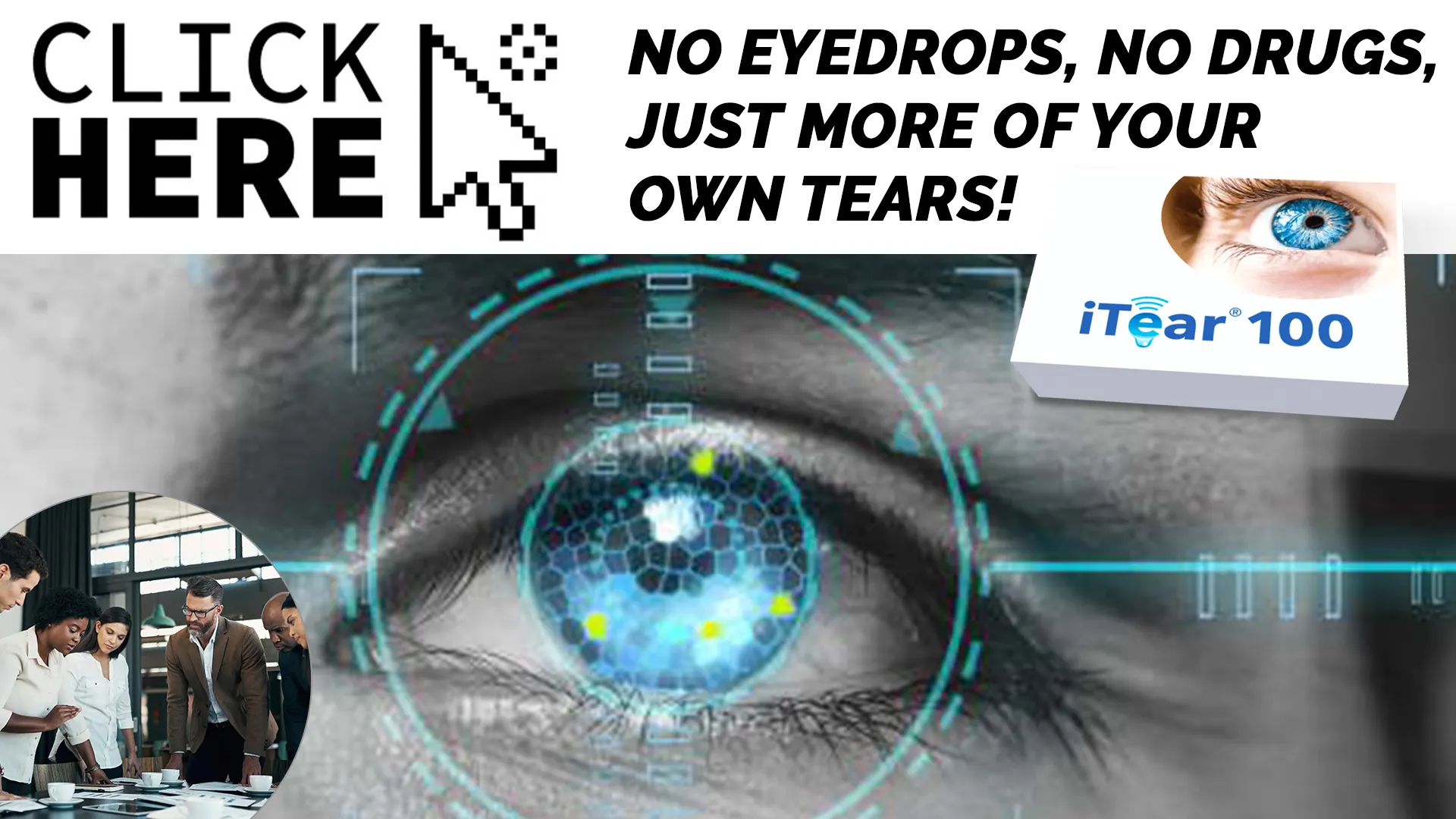Understanding Your Vision: Age and Dry Eye Symptoms
Age and Dry Eye
Understanding How Age and Dry Eye Intersect: Unveiling Solutions for ReliefAs we navigate through life's chapters, our body inevitably goes through changes, and one common, yet often overlooked, ailment that comes with aging is Dry Eye Syndrome. It's a condition that can cause a lot of discomforts, and its prevalence increases as we age. Fortunately, with advancements in medical technology, there are innovative solutions to alleviate the symptoms of dry eye without reliance on medications or constant use of eye drops. One such breakthrough is the iTEAR100 device - an FDA-cleared at-home medical device engineered to help you generate more of your own natural tears. Let's dive into understanding how age affects dry eye and how the iTEAR100 can be your ally in maintaining healthy, comfortable vision throughout the years.
Stop Your Dry Eye Now.

You're here because you have eye irritation or dryness, right? Well, you can stop having that problem. The iTear100 stops your dry eye in just seconds per use, AND you'll need it less as you use it! Click the image above - get relief now, and finally be free of dry eye issues for good!
Stop Your Dry Eye Now.

You're here because you have eye irritation or dryness, right? Well, you can stop having that problem. The iTear100 stops your dry eye in just seconds per use, AND you'll need it less as you use it! Click the image above - get relief now, and finally be free of dry eye issues for good!
The Science Behind Dry Eyes and Aging

As we mature, several factors contribute to the increased risk of Dry Eye Syndrome. From hormonal changes to a decrease in tear production, aging can take a toll on our eyes" ability to stay moist and comfortable. Also, certain systemic medications commonly used by older adults can exacerbate dry eye symptoms. It's a condition that affects a significant portion of the senior population, impacting daily activities, such as reading and driving.
Why Does Tear Production Decline?
Tear production is a complex process that involves various glands and tissues in and around the eyes. With age, these glands may become less efficient, leading to a reduction in both the quantity and quality of tears produced.
Changes in hormones, especially post-menopause in women, are also a contributing factor. Women are more likely to experience dry eye symptoms due to hormonal fluctuations that can affect tear secretion.
Risk Factors Unique to Seniors
Aside from physiological changes, lifestyle and environmental factors can also play a role. Digital eye strain, air conditioning, and heating systems can further dry out the eyes. Additionally, vitamins and supplements necessary for maintaining eye health may be missing from the diet of older adults.
Systemic diseases like rheumatoid arthritis, diabetes, and thyroid disorders, which are more prevalent in the aging population, are often associated with symptoms of dry eye.
Addressing Misconceptions About Dry Eye
There's a common misconception that dry eye is just a minor annoyance, but if left untreated, it can lead to more serious complications, including an increased risk of infection and potential damage to the cornea.
It's crucial not only to recognize the symptoms but to seek appropriate treatment. Proper management of dry eye syndrome can significantly improve one's quality of life, especially for aging individuals.
The Role of Medications in Dry Eye Symptoms
It's not just age alone that increases the risk of dry eye certain medications taken for a variety of health conditions can reduce tear production or disrupt the tear film.
Common culprits include antihistamines, decongestants, blood pressure medications, and antidepressants. It's important for healthcare providers to review a patient's medication list when managing dry eye symptoms.
Introducing the iTEAR100: A Drug-Free Solution for Dry Eyes

For those who want a natural, drug-free approach to managing dry eye, the iTEAR100 presents an appealing option. This at-home device is designed to stimulate your body's own tear production mechanisms, providing relief from the discomfort of dry, irritated eyes.
How the iTEAR100 Device Works
The iTEAR100 utilizes neurostimulation technology to activate the nerves responsible for tear production. By gently stimulating these nerves, the device encourages your eyes to produce tears naturally.
This innovative technology provides a rapid response, with many users experiencing relief in as little as a few minutes. It's a simple, quick, and effective way to address dry eye symptoms without the need for medication.
The Benefits of Choosing a Drug-Free Approach
Opting for a drug-free solution like the iTEAR100 means avoiding the potential side effects that can come with long-term use of eye drops or medications. It empowers users to manage their symptoms in a way that's in harmony with their body's own processes.
It's also an excellent option for those who have difficulty administering eye drops or who may be allergic to certain ingredients commonly found in over-the-counter options.
User-Friendly Design
The iTEAR100 device boasts a user-friendly design, making it easy for individuals of all ages to operate. The handheld nature of the device and its simple controls mean that you can use it with ease, whether you're at home or on the go.
Not only is it convenient, but the iTEAR100 also has a sleek and discreet appearance, ensuring that your dry eye treatment is as subtle as it is effective.
Stop Your Dry Eye Now.
You're here because you have eye irritation or dryness, right? Well, you can stop having that problem. The iTear100 stops your dry eye in just seconds per use, AND you'll need it less as you use it! Visit iTear100.com to learn more!
Lifestyle Tips to Complement the iTEAR100

While the iTEAR100 is a powerful tool in the fight against dry eye, there are lifestyle changes that can also help manage symptoms. Combined with the use of the device, these strategies can lead to optimal eye comfort and health.
Creative Ideas for a Dry-Eye-Friendly Diet
What you eat can affect your eyes. Including omega-3 fatty acids in your diet through fish, flaxseeds, and walnuts can help improve tear quality.
Staying hydrated by drinking plenty of water throughout the day can also support tear production and maintain overall eye health.
Digital Device Wisdom
In a world where screens have become ubiquitous, it's important to take regular breaks to rest your eyes. The 20-20-20 rule every 20 minutes, look at something 20 feet away for 20 seconds can reduce eye strain.
Adjusting screen brightness to match your environment and enlarging text size can also alleviate the stress on your eyes.
